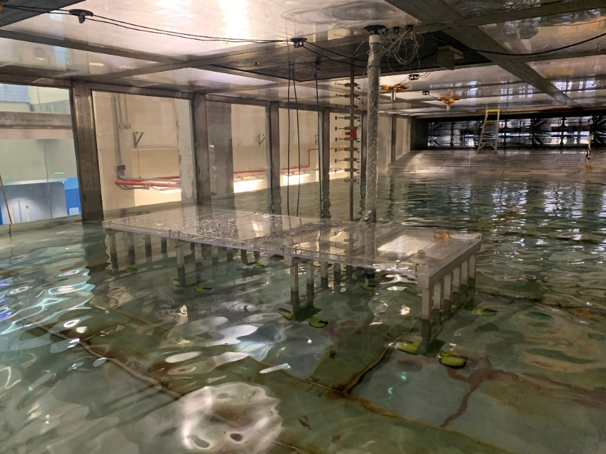The experimental definition of hurricane loading up to category 5 on coastal structures will be accomplished through physical testing in SUSTAIN. One of the greatest challenges for designing structures in hurricane prone areas like South Florida is the determination of wind and wave loads and their interaction on structures. Although, existing building and structural guidelines have already identified methods for calculating wind and wave loads, identifying the combined actions of wind and waves is still challenging and may vary depending on the geometry of the structure and the intensity of the storm. Therefore, in this study, two scale models were built as part of a Hurricane Resilience Research Institute (HuRRI) project for experimental testing. The first model represents a typical residential marine dock while the second one is a typical beam bridge. The models were instrumented and have been under testing under varying wind and wave conditions at SUSTAIN.
The obtained data from SUSTAIN testing will be used to determine the pressures and, subsequently, the loads that would act on a real structure exposed to similar conditions. Due to the difference in size of the two structures, different geometrical scales were used to build the models with the dock having a scale of 1:10 with overall dimensions of 12”-H x 9.5”-W x 41”-L, while the bridge has scale of 1:20 with dimensions of 18.5”-H x 34.75”-W x 96”-L (Error: Reference source not found). The substructure elements were made of aluminum grades 6061 and 6063 that provide good weldability and corrosion resistance. The superstructure components were made using acrylic sheets forming a “box-like” shape in order to have the required space for the stainless steel tabulations and vinyl tubes to acquire dynamic pressure acting on the surface of the models.
The models have been subjected to a variety of wind and wave forces with the applied loads determined through data acquired from 36 pressure sensors mounted on the front and bottom face of the bridge and the dock decks. Pressure loads are measured and recorded using an MPS4000 miniature pressurescanner manufactured by Scanivalve. The experimental conditions include periodic waves with different wave frequencies and wave heights at two water levels corresponding to mean high and mean low water levels, as well as wind generation from tropical storms to near Category 5 hurricane winds. Error: Reference source not foundThe figure below shows the overall setup prior to the application of experimental wind-wave conditions. Collection of data has been completed

Bridge model experimental setup for evaluating the combined action of wind and waveson the deck pressure distribution.




